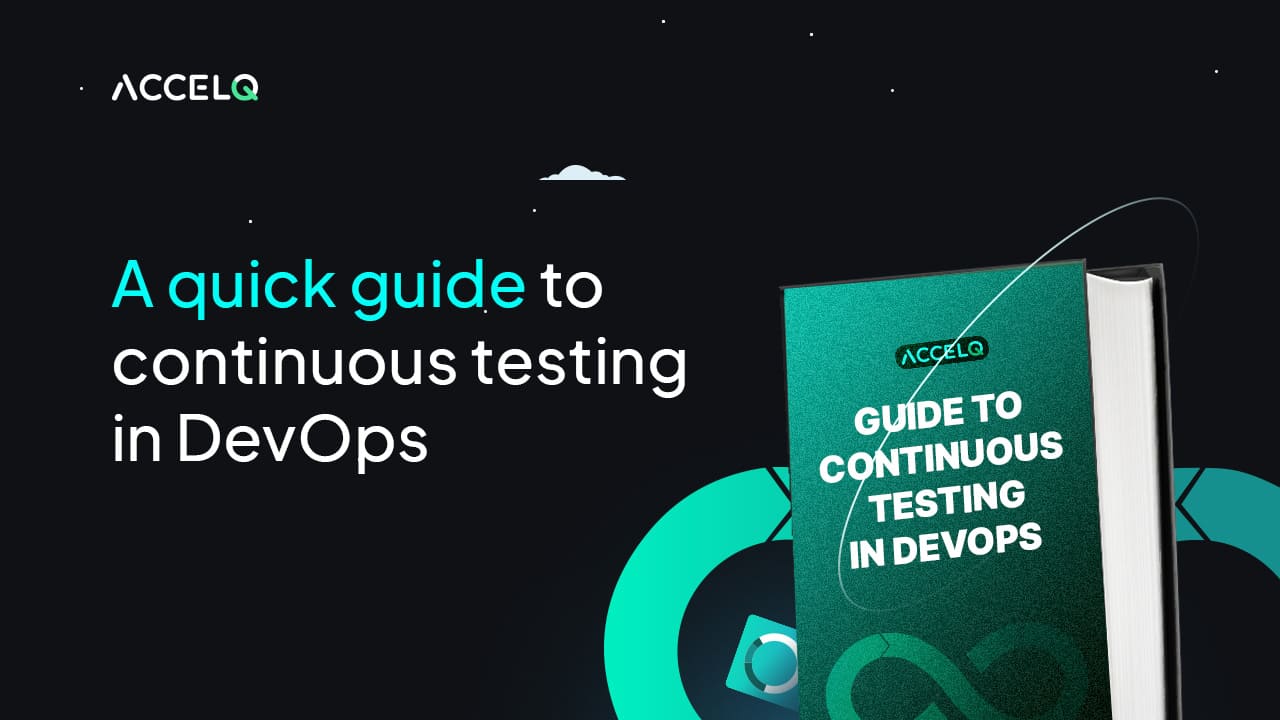A quick guide to continuous testing in DevOps

Continuous testing automatically tests software applications and components throughout the entire software development lifecycle (SDLC). Continuous testing in DevOps is the approach that integrates testing activities throughout the DevOps pipeline where test cases are included in every stage in the CI/CD pipeline. This starts from the stage of code commit, to build, to provisioning, to deployment, and all the steps that are involved along the way; everything is tested automatically. Let us go through each of these in detail.
What is Continuous Testing in DevOps?
The process of continuous testing triggers execution of automated tests with every code revision that happens at regular intervals. These tests are conducted as a part of the software delivery pipeline to help drive faster feedback on such changes pushed to the code repository. Continuous Testing was introduced initially to reduce the time taken to provide feedback to developers. The larger objective, however, is to ensure that testing is done more often, particularly at an individual level in the initial stages of development, and later testing the unified codebase.
The importance of continuous testing in DevOps sits on the big picture of bringing down the time to market software development and accelerate release cycles by reducing gaps between development and operations teams.
This can be achieved by consistent feedback on production or deployment readiness and the constant quality of the code developed. It is also required to note that continuous testing is critical to both agile development and DevOps pipeline. The process of continuous integration and delivery also heavily relied on Continuous testing.
Benefits of Continuous testing In DevOps
Every software application is unique and hence needs to be updated regularly to meet end-user requirements. With evolving software development techniques, timelines constantly are moved up thanks to the Agile approach becoming mainstream. Today changes in the code can be conveniently made in real time primarily due to Continuous Testing and the CI/CD pipeline. Further:
- Early detection of bugs: Continuous Testing starts early in the development cycle, just as developers start writing unit tests. It quickly helps identify and address defects at the source, thereby averting major issues in the pipeline later.
- Automating integration testing: As code is integrated into the shared repository in a Continuous Integration (CI) environment, there are automated integration tests that ensure code changes across all resources work in tandem without conflicts or breaking existing functionality.
- Validation through functional testing: Continuous Testing also includes functional tests that validate the software and if it confirms to meet its intended requirements and behaves correctly. Automated functional tests help catch regression issues and ensure that new features work as expected.
- Performance testing: Continuous Testing includes performance tests such as load testing and stress testing to ensure that the application can handle anticipated user loads and perform optimally.
- Default Security testing: Continuous Testing includes vulnerability scanning and penetration testing by default. This helps identify and address security flaws and vulnerabilities before they hamper production.
- Compatibility testing: It also helps verify if the software performs perfectly across various platforms, browsers, and devices which is critical when a diverse user base is present.
- Constant feedback loop: Continuous Testing provides an ongoing rapid feedback loop to developers, thus helping developers identify and fix issues early in the development process.
- Regression testing: Continuous Testing runs regression tests to ensure that new code changes do not bring in new defects or break existing functionality.
Best practices for continuous testing in DevOps
Consider the following as critical-
- High performing staging environments that are exact replicas of the production server is a must. However, it is important to note that this will attract considerable resources, bandwidth, and infrastructural investments; but this will help replicate the performance of the application in a production environment.
- The right set of tools and automation frameworks for each step of test automation such as unit testing, API testing, and UI (User Interface) testing plays an important role. While there are multiple test automation frameworks available that allow concurrent test execution; choosing the codeless route can be beneficial. Selenium and Cypress are two frameworks that are popular automating web-app testing while Jenkins and Travis are popularly used CI/CD tools.
- Evaluation of test results to look for any false negatives or false positives is important as either of these can disrupt the production stage.
- A proper roll back plan is essential to ensure that that before pushing any code in the production stage, all critical data is backed up and ready.
How can Automated Platforms help Continuous Testing in DevOps
Automation drives shift left in DevOps, but its potential can be completely used only when testing is automated with an on-demand, reproducible process. Automated testing platforms, such as ACCELQ, help use best practices in creating a continuous testing model generating real-time data on the current build status. It also provides testers with the ability to make better-informed decisions on where, when, and how to test. It can-
Align with CI/CD
CI/CD are the central tenets of the DevOps value stream. Therefore, it’s vital to establish a continuous testing setup that generates reports, monitors defects, and analyzes test coverage. This essentially means that developers can go about their work knowing that a recent application build failed through notifications describing automated test fail, issues with a new code release, or a last-minute code change.
Lower Maintenance costs
Automated platforms enable testers to integrate with CI/CD and work in the background to ensure that each new commit or code release is tested. They give early warning of any issues or defects. As such, DevOps practitioners can reduce the maintenance costs by rectifying the abnormalities at the source and redirecting the resources dedicated to testing and associated outlays to the following code release or project.
Facilitate Faster Release of High-Quality Applications
Eventually, it all comes down to speeding up the processes and delivering better applications faster. The continuous testing model can dramatically improve the release-testing loop by minimizing the chances of any last-minute errors to enable a faster, more flexible release process.
Write faster automation
Rather than writing complete test scripts from scratch each time, low-code testing platforms allow quick reuse of code and test scripts and further ease the test automation process. From rapid onboarding of the developers and testers to faster test execution and streamlined reporting, the low-code approach can significantly improve overall efficiency and sustain the effectiveness of the automation suite.
Enable DevOps with Continuous testing
Often, the best logical solution to a complex problem emerges due to discerning the best interaction between building blocks. These blocks correspond to:
- No code test automation makes it possible to automate the business logic in natural language and facilitates modularity, reusability, and maintainability for your tests.
- Full-stack automation testing reduces the effort required to write automated tests and helps capture more of the app’s behavior.
- Business process reusability optimizes pre-built workflows, facilitates the creation of reusable test components, and extends test coverage.
- AI-based self-healing accommodates configuration changes, detects failures, and helps understand and fix the underlying cause.
- Analytics and heuristics for governance expedite automated testing planning, test management, traceability, and impact analysis.
In a Nutshell
Continuous testing presents an effective way to accelerate building and deploying applications. Besides, this approach is fundamental for implementing a structured test automation framework and leveraging test automation improvements. But, to achieve its full potential, it needs to be an essential part of the DevOps pipeline rather than an afterthought. As a Market Leader in Test Automation Suites, ACCELQ empowers the DevOps initiatives with codeless automation, ensures coverage, and reduces maintenance costs.
Discover More
 Efficient Test Coverage: Maximize Test Coverage in Less Time
Efficient Test Coverage: Maximize Test Coverage in Less Time
Efficient Test Coverage: Maximize Test Coverage in Less Time
 Accelerating Test Automation of FinancialForce
Accelerating Test Automation of FinancialForce
































